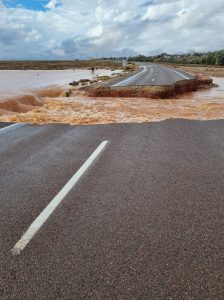Biggest rain in a decade
Katherine Tuft
28 February 2022

During the middle of January, we had 119mm of rain which is 75% of our annual average…. in a week!
Some of the rain fell very heavily in intense and spectacular storm fronts. Nathan (Conservation Land Management Officer) and myself, stationed themselves out at the reserve to respond to the event and check the fences. Leanne (UNSW researcher) and three students were out there as well. It has been 11 years since the last comparable rain event and the single biggest dump in the reserve’s 24-year history. The front responsible for the dumping
The front responsible for the dumping
 Nathan checking the fire pit & Student Yasmine flooded in to her bed room at the research stationWe’re pleased to report that the Arid Recovery fences stood up exceptionally well to the downpour. There were no significant issues with the fence other than a few minor washouts that were easily filled with rocks. It’s a testament to the care that staff and volunteers have put into the fence over the years. Unfortunately, the tracks haven’t fared so well, with some severe erosion in places that we have started to assess for repairs.
Nathan checking the fire pit & Student Yasmine flooded in to her bed room at the research stationWe’re pleased to report that the Arid Recovery fences stood up exceptionally well to the downpour. There were no significant issues with the fence other than a few minor washouts that were easily filled with rocks. It’s a testament to the care that staff and volunteers have put into the fence over the years. Unfortunately, the tracks haven’t fared so well, with some severe erosion in places that we have started to assess for repairs. Nathan assessing the road damage and checking fences
Nathan assessing the road damage and checking fences
The rain also washed away the only road into Roxby Downs, making the township its own secluded island. There’s been a fair bit of media interest in the rain event, with Roxby Downs and Arid Recovery making the national news. I even had the opportunity to speak to Patricia Karvelas on Radio National Breakfast. You can listen to my interview here and watch the Roxby Downs story here.
 Our only road in and out turned into a waterfall (photo credit: Spud's Roadhouse)The reserve has burst to life with an abundance of vegetation, frogs, shield shrimp and birds popping up all over. Our new climate change research graduate, Jack Bilby, has quickly pivoted his work from testing soaks as drought-relief measures to understanding recovery of vegetation after drought.
Our only road in and out turned into a waterfall (photo credit: Spud's Roadhouse)The reserve has burst to life with an abundance of vegetation, frogs, shield shrimp and birds popping up all over. Our new climate change research graduate, Jack Bilby, has quickly pivoted his work from testing soaks as drought-relief measures to understanding recovery of vegetation after drought.
 Left: Trilling frog (Neobatrachus sudellae); Right: shield shrimp (Triops australiensis)
Left: Trilling frog (Neobatrachus sudellae); Right: shield shrimp (Triops australiensis)  Left: Sturt Desert pea (Swainsona formosa); Right: a central bearded dragon hiding in vegetation
Left: Sturt Desert pea (Swainsona formosa); Right: a central bearded dragon hiding in vegetation
Our annual pitfall trapping survey is quickly approaching and we are excited to see how our small mammals and reptiles have bounced back.